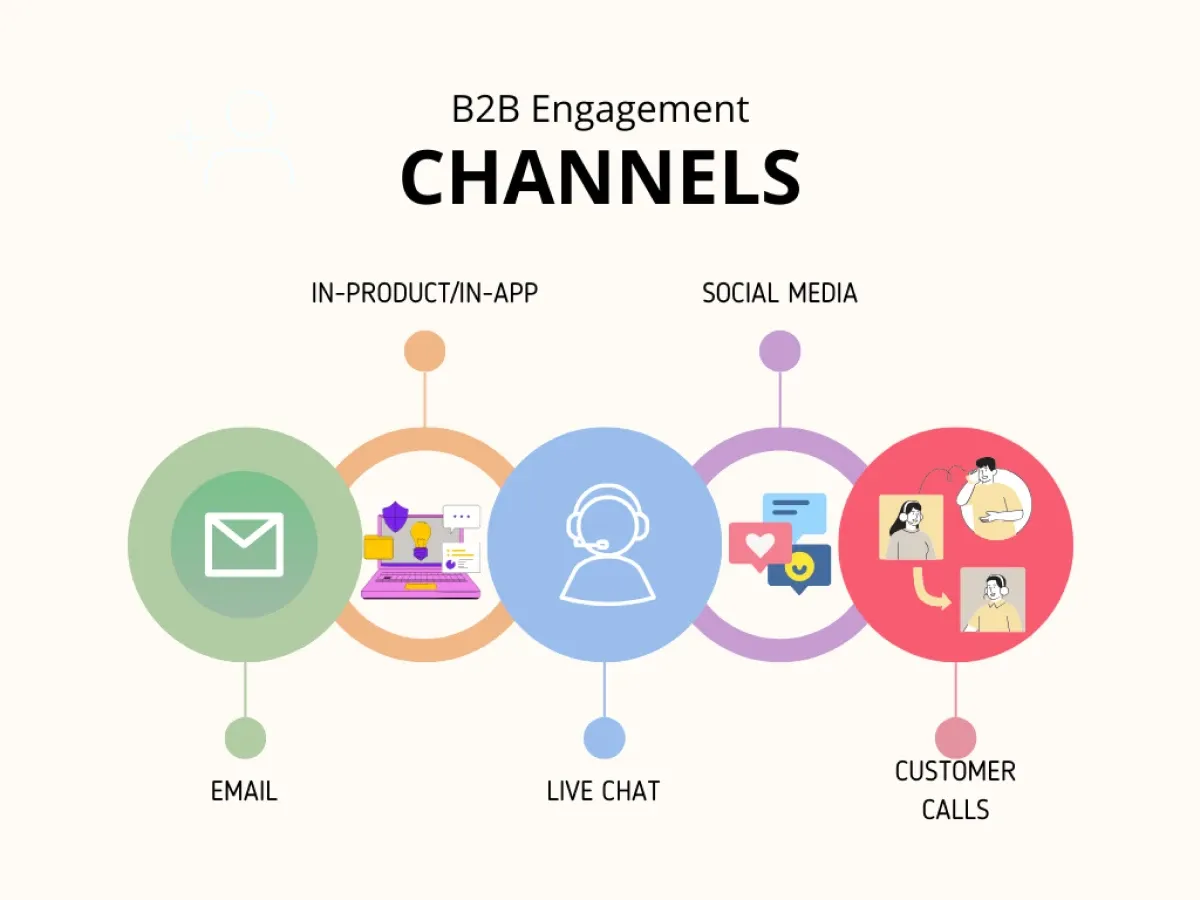Engaged for life – how to optimize the B2B user engagement lifecycle
Discover why understanding the engagement lifecycle is key, how to tailor tactics for each stage, and select the ideal channels for a winning B2B user engagement strategy.

What would you think of a highway built for two-way traffic, but only usable in one direction? Surely, you would look at it with skepticism and perhaps, even curse the days when you’re stuck on the wrong side. That’s essentially what happens when you launch a B2B product without a strong user engagement strategy.
Simply getting your product into the market isn't enough. You need ongoing interaction with your users – their active participation is important, or else, all your efforts will have been for naught. In other words, you need to deliver a highway that works both ways.
Engagement is more than just product usage. It's a deep dive into a user's level of interest, satisfaction, and behaviors that keep them coming back for more – all of which form the foundation for unlocking true business value.
Understanding the user engagement lifecycle is critical. Users don't interact with your product the same way throughout their relationship with you. Their engagement levels differ based on where they are in the lifecycle.
A quick look at the user engagement lifecycle

The B2B user lifecycle consists of distinct stages –
- Acquisition: This initial stage focuses on attracting potential users who face challenges your product can solve.
- Activation: Once a user signs up, the goal is to activate them by guiding them through the initial product setup and encouraging early use.
- Adoption: This stage is where users explore the full potential of your product and discover its value.
- Retention: Keeping users engaged and satisfied over time is crucial. The idea is to reap long-term value and prevent churn.
- Advocacy: This could be thought of as the ultimate goal of engagement – to transform satisfied users into brand advocates. You want happy and loyal users to share great things about you so that it builds trust in the market and others among your target audience pay attention to what you have to offer and hopefully, join your list of customers.
Look at the different stages and you’ll find that each is unique in the user’s understanding of your business and its products, their willingness to work with your platform or app, and their maturity with product usage. Clearly, each stage calls for a targeted user engagement strategy that makes people stick around.
No one channel can engage them all
Users don’t engage with businesses through just one channel (wouldn’t that be the dream!). They interact with you through multiple avenues and touch-points. Why should you bother with a multi-channel strategy for engagement?
You can reach users throughout their journey – Different channels excel at reaching users at different points. Emails might be ideal for initial outreach, while in-app messaging allows for real-time guidance within the product, making your engagement tactics relevant to users in the context of their actions.
You can cater to user preferences – Users have varying communication preferences. Some might prefer the convenience of email, looking at information in their own sweet time, while others might value the immediacy of live chat within the platform itself when they encounter a roadblock.

Let’s take a look at the different channels that work best for B2B communication and engagement.
- Email – It’s always there, ready to deliver your messages. You can be as succinct or verbose as you like. So everything from a quick feature update to a detailed breakdown on how to go about conducting a certain workflow can be delivered via email. Email lets you communicate on your own schedule, which can be great for both you and your recipients. However, there is no denying the fact that inboxes are overloaded with tons of emails and yours can easily get lost in it.
- In-product engagement – If you want sharper focus and more attention from your users, in-product engagement is the way to go. When users are actively using your product, they are "in the zone", which means they will be highly receptive to any message you send their way. Think of the relevance of an in-product survey right after someone uses a feature, compared to an email a day later when they've probably forgotten half of it.
- Live chat – This is a perfect channel for when your users need real-time support from a real person. Live chat lets you have a personalized conversation with users so that you can deliver more than just a canned response. You can chat back and forth to give your users the exact help they are seeking.
- Social media – In B2B settings, social media acts not just as a communication channel but also as a community-building space. Whether attracting potential customers and users with industry insights or hosting live Q&A sessions and engaging in discussions around your product use, social media can help keep prospective and existing users engaged. According to B2B marketing statistics, businesses that leverage social media for engagement are more likely to build lasting relationships and increase their reach within their target market.
- Customer calls – Sometimes, the good old-fashioned phone call is the best to engage with customers directly, especially when they are facing a complex issue or need a detailed demo of the product. The in-depth discussions and personalized attention go a long way in engaging with your users.
Optimizing engagement for every stage of the user lifecycle
By looking at where your user is in their journey with you, you can zero in on the channels to use for engaging them and come up with actionable content and tactics.
Optimize acquisition
Your first chance to make an impression means you can engage people, even if they are not actual users of your product yet, to build trust and get them to believe in your expertise. You can use different content types like blog posts, white papers, or even webinars to connect and engage with your target audience. You can also invest in SEO, especially in boosting organic search rankings, so that people can easily find your solution when searching for answers to their challenges.
Optimize activation
Once a user signs up, you need to get them to be actively using your product. Since new users can get overwhelmed with a new UI, it’s important to focus on giving them a clean design that is easy to navigate and helps them get to the activation moment quickly. You can use in-app tutorials, tooltips, pop-ups, checklists, or a mix of them all, making the onboarding process a smooth ride. You can also make use of personalized onboarding emails to showcase the value proposition of your product. These emails can be triggered based on user actions, so they end up receiving relevant information at the right time. Make live chat support readily available so that any users who are struggling during the initial setup can easily get to an expert customer service rep. This will prevent frustration and the possibility of the user turning inactive or churning.
Optimize adoption
Just because users are onboarded doesn't mean they're automatically using your product to its full potential. You need to continuously engage with them and encourage them to explore and reap the full value of your offering. Leverage in-app pop-ups that appear at relevant moments during a user's workflow. These targeted messages can highlight new features, showcase relevant use cases, or offer helpful tips, all aimed at driving continuous product adoption. You can also craft engaging emails or even in-app content series that educate users about different product functionalities. Tailor the content based on user behavior and progress within the product. Such a personalized approach will keep adoption relevant depending on how the user is "acting" or "reacting" to your products, value proposition, and the content you target them with.
Optimize retention
Retention is at the heart of keeping yourself relevant to your users. You can implement customer success programs that provide ongoing support and guidance for your users. This could include assigning dedicated account managers, conducting personalized training sessions or office hours, or creating a knowledge base with helpful resources. The last one is a great customer retention tactic since nearly 70% users want to resolve issues independently. You can also be proactive with your customer support efforts by scheduling regular check-ins via email, phone calls, or in-app surveys to gather feedback from users and identify any potential issues before they escalate into churn.
Optimize advocacy
Turning happy users into vocal advocates is a key goal in the user engagement lifecycle. You can show the positive impact your product has on your users through several ways – testimonials, case studies, and interviews are just some of the ways in which you can do this. publicly recognize and reward your loyal users. You can also feature your customers in blog posts or nominate them for industry awards. You could also co-create and co-market with your users. Imagine being able to host webinars or events together – it leverages your brand reputation and industry expertise while allowing you to attract new customers. In return, you could offer your advocates some perks like early access to new features, discounted pricing on subscriptions, or co-branding opportunities.
Cultivating long-lasting, meaningful interactions throughout the engagement lifecycle
As a business, you never want to settle for transactional B2B relationships. Not only do you need to acquire new customers, you need to keep them actively engaged with your product and keep them coming back for more, month after month, year after year.
Whether you decide to prioritize in-product engagement to capture your users in the moment of highest focus and context, or whether you choose to tap into multiple channels and touchpoints to engage users throughout the entire journey, the important thing to remember is that long-term relationships are built on trust. And trust can only be had when you continuously deliver value.
This is why you need to be relevant and meaningful to your users no matter where they are in their journey– whether they have just signed up for your product or have been around for years already.
Tapping into the engagement lifecycle and delivering the right message and the right content at the right time can spell the difference between a passive user base that just hangs around, signing in to your product once in a while to do their jobs, or an active, thriving community of loyal, maybe even passionate advocates for your brand.
